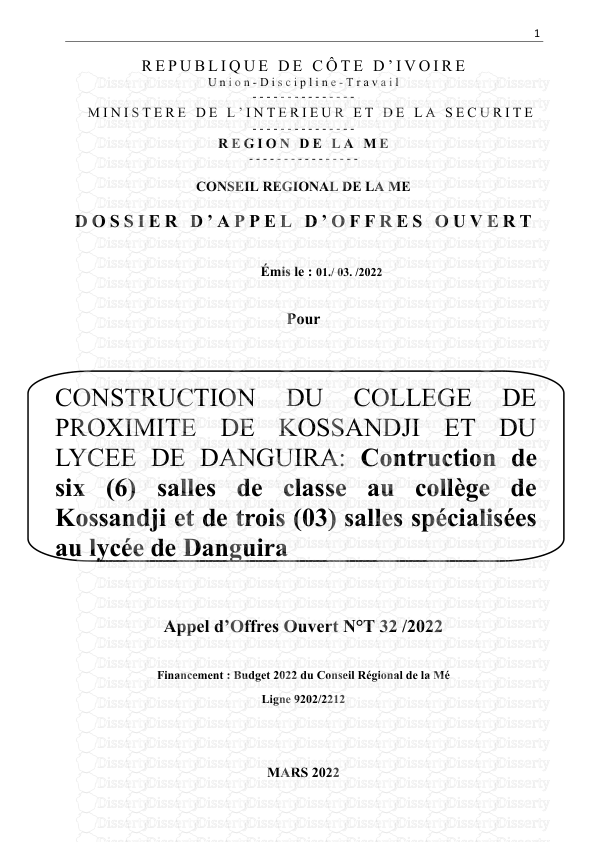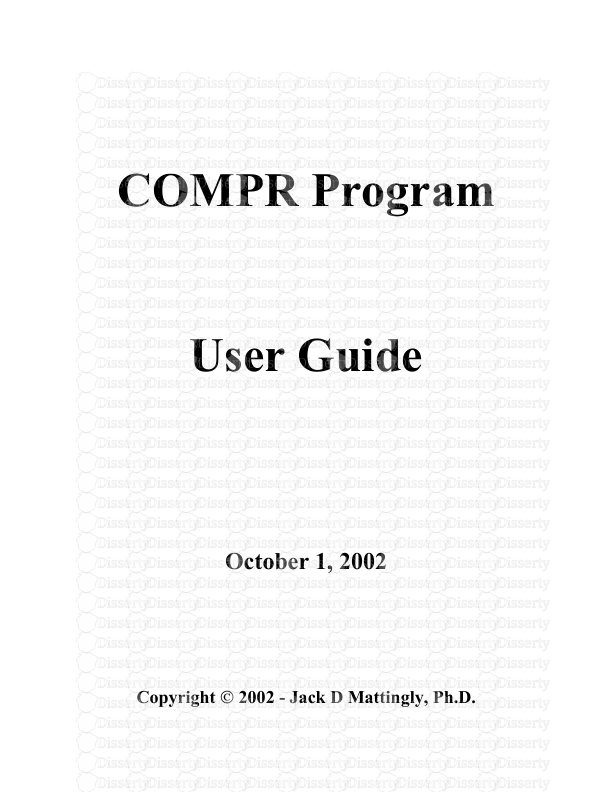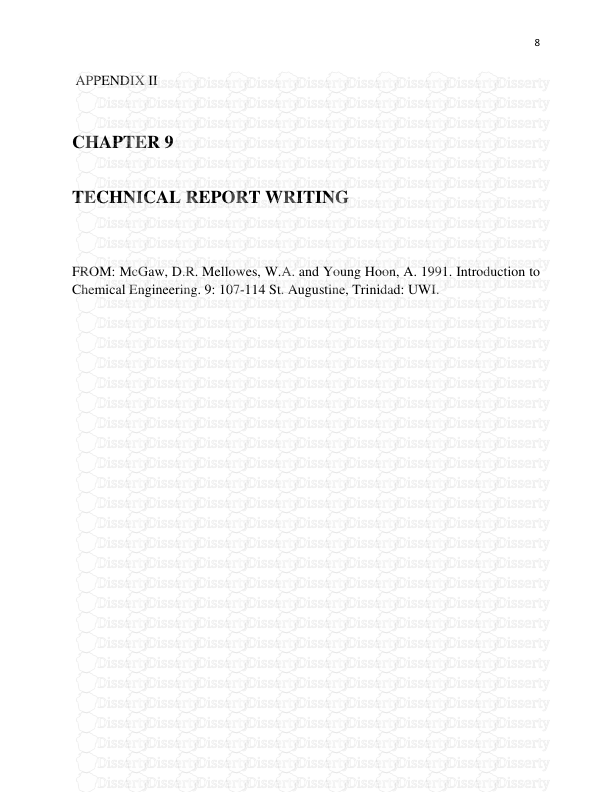8 APPENDIX II CHAPTER 9 TECHNICAL REPORT WRITING FROM: McGaw, D.R. Mellowes, W.
8 APPENDIX II CHAPTER 9 TECHNICAL REPORT WRITING FROM: McGaw, D.R. Mellowes, W.A. and Young Hoon, A. 1991. Introduction to Chemical Engineering. 9: 107-114 St. Augustine, Trinidad: UWI. 9 9.1 BASIC CONSIDERATIONS Once a piece of technical work has been completed, it is necessary to communicate the content of the work to the interested parties, in as efficient a manner as possible. Efficient communication of the work is just as important as the work itself, whether it be in the form of a thesis, journal, paper or technical report. There would normally in fact be little point in carrying out the work in the first place if the results are not communicated to appropriate interested parties in some form. One of the most important considerations when writing up the work is to think of the person who will be reading it. While preparing the document the writer should be continually asking himself if it is being written in such a manner that the reader will be able to grasp the information immediately. All the means at the writer's disposal should be used to present the work as clearly as possible. Before starting to write the document, the writer should have the basic aims of the work clearly in his mind and should at all times be sure that the fulfilment of these aims is being transmitted to the reader. 9.2 PROCEDURES INVOLVED IN DEVELOPING A THESIS OR REPORT The mechanics of taking a piece of finished research work and putting it together in the form of a written document involves a number of steps which may be summarised as follows: (a) Before starting on the thesis or report, ensure that: (i) Data has been collected and correlated (ii) Results have been analysed (iii) Conclusions have been drawn (iv) Recommendations have been decided upon At this stage the writer must have readily available all the material which he thinks he is going to use. 10 (b) The first major decision to be made is concerning the layout to be used. At this stage the writer has to decide on all the Section or Chapter headings appropriate to the work being reported. (c) The next step is to examine each of the projected sections in turn and decide on what material is to go in the section. Each section may then be written up once the organization of the presentation of ideas in the section has been decided upon. (d) Read through the Sections in the correct order in order to examine the continuity between chapters. Each chapter should follow naturally on from the one preceding it. (e) Rewrite as appropriate until satisfactory. (f) Detail Tables, Graphs, Plates, Nomenclature and References. (g) Arrange Typing. (h) Prepare for Presentation, e.g. Copying and Binding. It is normal to get someone to read the report at one or more stages before typing. For a thesis the supervisor should check each section as it is written and advise on redrafting. He should then reread the finished work before typing. 9.3 LAYOUT This refers to Section or Chapter headings and the order in which they are used. The actual choice of headings will depend on the work and the way in which it was carried out, so there is no absolute laid down procedure. A typical layout for a report on a technical project may be as follows: 11 Title Page Acknowledgements Abstract or Summary Contents 1. Introduction 2. Literature Survey 3. Theory. 4. Apparatus and Experimental Methods (Experimental) 5. Results 6. Discussion 7. Conclusions 8. Recommendations Appendices Nomenclature References (or Bibliography) It is worthwhile noting the method of numbering the important sections which form the bulk of the thesis. The sections not numbered are associated with presentation and the provision of ancillary information. There may be sub-sections within each section which could also be numbered for easy cross referring. The emphasis should be on finding the best sequence of Chapter headings to suit your project. 9.4 INDIVIDUAL SECTIONS IN MAIN BODY OF REPORT 9.4.1 TITLE The title is the first material that the reader sees and so it should be a clear, comprehensive yet brief description of exactly what the report contains. It need not be 12 written first, it is often written last. It may be taken from the first sentence of the summary or abstract. 9.4.2 SUMMARY This is an extremely important section especially in reports and papers, because it tells very briefly the prospective reader exactly what the ort contains. It should contain a clear account of the important points of the report. The opening sentence should restate and. amplify if necessary main purpose of the work as indicated in the title. This is followed by a statement of more important aspects of the investigation finishing with the main conclusions and recommendations. It should be a logical chain of: (i) Reasoning -What was the question? (ii) Observation -What was the evidence? (iii) Deduction -What are the conclusions? without a single weak link in it. 9.4.3 INTRODUCTION The introduction should supply the background information necessary to an understanding of the work described. The considerations used in the development of the Introduction may be: (i) A Statement of the general field of interest. (ii) Purpose of the investigation and the nature of the problem being investigated (iii) Scope of the investigation including boundaries and other limitations. 13 The aim throughout should be to interest the reader and answer the questions: (a) Why was this work embarked upon? (b) What was the overall aim of the work? 9.4.4 LITERATURE SURVEY The Literature Survey should only contain previously reported material which has a .bearing on the problem which has been investigated. When writing this section, in particular, the author must keep reminding himself of the overall aims of the work. Discard any material that does not have a direct bearing on the investigation. The general method of approach would normally be to begin by summarizing the relevant material from each paper. The literature survey may then be written in its final form by comparing, contrasting and critically evaluating all the relevant material in relation to the problems associated with the investigation. Unless one of the major objectives of the investigation was the, carrying out of a literature survey in a fairly broad field then the length of the Chapter should generally be less than 10-15 pages. 9.4.5 THEORY, This should contain an explanation of any theoretical concepts and analyses used in the investigation. If an analysis is relatively short it may be included in full in this section. If it is many pages long, it may be more convenient to include the derivation of the initial equations and the final solutions only in the text with the full analysis put in an Appendix. It is important to state clearly the assumptions made in any analysis. 9.4.6 APPARATUS AND EXPERIMENTAL METHODS This section is relatively straight' forward and may be subdivided typically as follows: 4.6.1 Basic concept of apparatus 14 4.6.2 Description of specific piece of equipment being investigated -Engineering Drawing 4.6.3 Description of complete circuit used including ancillary equipment and services 4.6.4 Instrumentation -Include estimated accuracy 4.6.5 Experimental Programme -List variables and ranges investigated 9.4.7 RESULTS All relevant results should be presented in this section. They are usually best presented in tabular or graphical form for easy understanding. The first tables may contain the input data for the theory as obtained from the experimental work. Calculated result will be in the later tables, or in graphical or equation form. Specimen calculations, if considered necessary may be put in an Appendix. 9.4.8 DISCUSSION The discussion will vary in scope, length and complexity according to the nature of the investigation. The discussion should however be well organised, logical and easily followed. Points worth discussing in this section are: (i) Accuracy. of each individual reading and the effect on the overall accuracy of the results. (ii) Comparison of results with these calculated theoretically and the reasons for any derivations with possibly special mention of the assumptions made in the theory. 15 (iii) Comparison of your results with other reported theories and/or results and reasons for any derivations. (iv) Explain how the results achieved may be equated with the initial aims of the work. (v) Discuss the practical application of the results. (vi) Discuss what further steps may be necessary. Controversial issues should be discussed lucidly and fairly. Where results differ from previous ones, an explanation rather than a refutation should be sought. Anomalous results for which no explanation is readily available may be stressed rather than concealed, since they may open up new possibilities of exploration. 9.4.9 CONCLUSIONS All the conclusions may have been reached in the Discussion but it is useful to have them grouped in one section for easy reference. Make sure that: (a) They follow logically from the evidence presented in the Discussion. (b) They are arranged in a logical order, e.g. in decreasing order of importance. (c) Secondary conclusions not important enough to -have been listed uploads/s1/ guide 65 .pdf
Documents similaires










-
46
-
0
-
0
Licence et utilisation
Gratuit pour un usage personnel Attribution requise- Détails
- Publié le Nov 27, 2021
- Catégorie Administration
- Langue French
- Taille du fichier 0.0623MB


